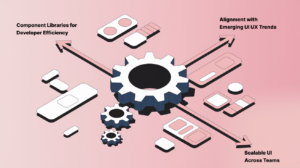Introduction

Building digital products at scale used to be a rare challenge. Today, it’s the norm. Whether you’re working at a fast-growing startup or part of a global team, the need for design consistency across platforms is non-negotiable. When designers and developers operate without shared tools or visual systems, things fall apart. User experiences drift, code gets duplicated, and what once felt elegant becomes chaotic. This breakdown is especially common when there’s no foundation, no design system, to tie it all together. This is exactly why forward-thinking teams, especially those offering UI UX design services, now rely heavily on design systems to stay efficient and aligned. And it’s also why students pursuing a masters in UX design are being trained to think in terms of systems, not just interfaces. A scalable UI isn’t a nice-to-have anymore. It’s mission-critical.
Whether you’re designing for desktop, mobile, or wearables, the ability to scale your product visually and functionally across multiple teams depends on how well your design decisions are systematized. That’s where a smart, reusable foundation, aka a design system, becomes invaluable.
What is a Design System? (And What It’s Not)
At its most practical level, a design system is a shared, documented ecosystem of component libraries, visual patterns, interaction rules, and coded logic that all work together to create a scalable UI. It removes the guesswork. It prevents your team from solving the same problem ten different ways.
If you’ve ever taken or considered a masters in UX design, you’ve probably already encountered this concept. These programs often emphasize component-driven thinking and systems architecture as key design skills. Why? Because the real world demands reusable, modular design, not just one-off screens.
Here’s how a design system compares to common design assets:
|
Tool |
Purpose |
|
Style Guide |
Defines branding: fonts, colors, logos |
|
Pattern Library |
Documents UX solutions to recurring problems |
|
Design Tokens |
Encodes spacing, typography, and color values for reuse |
|
Component Libraries |
Provide reusable UI elements synced with dev frameworks |
Well-structured component libraries are often linked with live documentation tools like Storybook or integrated into frameworks that engineers use daily. That’s what makes a true design system powerful, it bridges the gap between vision and execution.
Without a system, your product grows messy. With one, you create cohesion, flexibility, and faster iteration, while keeping up with evolving UI UX trends.
Why Design Systems Matter to Modern Product Teams
The real value of a design system isn’t in how pretty it looks, it’s in how much friction it removes.
Modern product teams, especially those building across mobile, web, and emerging platforms, need reliable building blocks. Design systems, when implemented well, give teams a single source of truth. And that truth lives inside tools like Figma, React, and design documentation, not in someone’s head or Slack history.
This alignment matters deeply to UI UX design services firms. Without it, handoffs are slower, codebases get bloated, and designers keep solving the same layout issues repeatedly. But with a system, junior designers can produce senior-level outcomes, and developers can build interfaces without pinging design for clarification every 10 minutes.
Let’s be specific:
-
A solid design system improves component libraries so you don’t rebuild buttons and cards from scratch.
-
It allows for faster onboarding and better scalability, key metrics that matter in teams using Agile or CI/CD pipelines.
-
It ensures your product can adapt to modern UI UX trends, such as dark mode, dynamic theming, and accessibility.
And this isn’t just anecdotal. According to Sparkbox, teams that rely on a centralized design system experience up to 47% faster design-to-development handoffs. For high-velocity teams, that’s a significant edge.
It’s no surprise, then, that most masters in UX design programs now include dedicated courses or workshops on system design. The industry expects new designers to not only work within these systems, but to actively help build and evolve them.
Core Benefits of Design Systems

A. Scalable UI Across Teams
As your product team grows, so does the complexity of maintaining visual and interaction consistency. A good design system acts as a guardrail, making sure that every screen, from marketing pages to onboarding flows, feels like it belongs to the same family.
That’s the core of a scalable UI: enabling multiple teams to build autonomously without drifting away from the core design language. Whether you’re working with five designers or fifty, the system makes sure everyone’s speaking the same visual language.
Example: IBM’s Carbon Design System supports over 200 teams globally. It standardizes layouts, interactions, and branding across web apps, internal tools, and cloud platforms. Without it, IBM would spend an enormous amount of time realigning fragmented UI across teams.
B. Component Libraries for Developer Efficiency
Efficiency isn’t just about speed, it’s about repeatability. Well-built component libraries allow developers to pull pre-tested components directly into codebases without second-guessing UX specs or writing the same CSS twice with or without a masters in UX design.
- Button? Ready.
- Modal? Documented.
- Error banner with accessibility support? Already built and in production.
With integrated libraries in tools like Storybook or GitHub, and synced with design tools like Figma or Sketch, design-to-dev collaboration becomes seamless. It also reinforces design intent through every build.
C. Alignment with Emerging UI UX Trends
Design systems help teams stay ahead of shifting UI UX trends. Themes like dark mode, adaptive color tokens, and variable font sizing can be introduced once in the system, and instantly applied across every surface.
This modular structure is particularly important for teams working in modern frontend architectures, like micro frontends or headless CMS platforms. And in most masters in UX design programs today, students are taught to manage and evolve these systems as trends shift and user expectations evolve.
How to Build or Adopt a Design System
So, where do you begin?
Start with an audit.
Inventory your current styles, components, and interaction patterns. Identify duplicates, inconsistencies, and areas for consolidation.
Choose your tools.
Most teams rely on a trifecta:
-
Figma or Sketch for design
-
Storybook for front-end components
-
Zeroheight or Notion for documentation
Define your structure.
Your system should include:
-
Design tokens (colors, spacing, typography)
-
Reusable components
-
Usage rules
-
Accessibility considerations
-
Contribution guidelines
Set governance early.
Who maintains the system? How are updates reviewed? A lack of ownership is a fast way to kill adoption.
Mini Case: Spotify’s GLUE design system (short for “Graphical Language for User Experience”) evolved from a grassroots effort into an organization-wide tool. Its success came from gradual rollouts, team training, and clear rules for contribution and feedback.
Technical FAQs
Q1: How do design systems improve developer productivity?
They remove ambiguity. Developers can trust that the component library reflects the latest visual and functional requirements. This reduces rework, bugs, and communication overhead, especially across remote or hybrid teams.
Q2: Can a design system support multiple products?
Yes, and it should. Modular systems can flex to fit different branding, layouts, or accessibility needs, while still sharing a common core.
Q3: What tools are most commonly used to manage design systems?
Figma (for design), Storybook (for code), Zeroheight or Notion (for docs), and GitHub (for version control) are industry standards. Larger teams might also use design tokens with tools like Style Dictionary or Theo.
Q4: What are design tokens and why do they matter?
Tokens are small, reusable variables for colors, spacing, fonts, and motion. They allow consistent application across platforms and make global changes painless, e.g., switching from light to dark mode system-wide.
Q5: How do design systems evolve over time?
Through feedback loops. The best systems are never “done.” They’re reviewed quarterly, updated as UI UX trends evolve, and tested across new product lines. Larger organizations often assign a dedicated design systems team to maintain governance.
Challenges and Pitfalls to Avoid
Let’s not sugarcoat it, building a design system isn’t easy. Here are the common traps to avoid:
-
Overbuilding before adoption: Don’t spend six months on a system no one uses. Start lean, release fast.
-
Lack of documentation: If people can’t understand how to use the system, they won’t.
-
Designer-dev disconnect: If design and code versions drift, trust erodes.
-
Forgetting to measure impact: Track design debt, handoff time, and component reuse to prove ROI.
-
Ignoring contribution workflows: Without contribution rules, you’ll end up with chaos.
Pro tip: Audit your design system every 6–12 months to keep it healthy and evolving.
Why UX Education Emphasizes System Thinking
Ten years ago, UX education focused on personas, wireframes, and usability testing. Those things still matter, but today, they’re not enough.
Modern masters in UX design programs recognize that real-world UX happens at scale. Students are now expected to:
-
Design in systems, not screens.
-
Create reusable patterns, not custom solutions every time.
-
Contribute to design documentation and governance.
In fact, a Nielsen Norman Group survey found that 78% of Tier-1 UX programs now include coursework on design systems and design ops. It’s not just about creating things, it’s about creating things that others can use, extend, and rely on regardless if they have a masters in UX design
Design Systems as a Strategic Asset
To wrap it up: design systems are no longer optional. They’re a critical layer in your product stack.
They unify teams, power scalable UI, accelerate workflows. And they help products adapt faster to changing user needs and UI UX trends. For anyone serious about building consistent, resilient digital experiences, especially those involved in UI UX design services or pursuing a masters in UX design, understanding and leveraging design systems is essential.
Whether you’re starting from scratch or evolving an existing library, treat your design system like any other product. Invest in it. Test it. Evolve it. Because when your foundation is strong, everything else moves faster.
Do you like to read more educational content? Read our blogs at Cloudastra Technologies or contact us for business enquiry at Cloudastra Contact Us